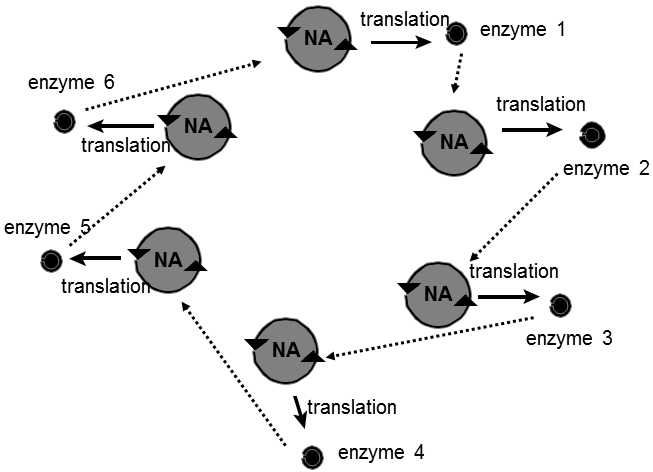X.3.1.3 Hypercycle models enable testing of whether spatially defined structures constitute a necessary condition for biological evolution
The hypercycle model, which was developed mainly by Nobel prize winner for chemistry, Manfred Eigen, is a theoretical model of a self-replicating system, whose elements are arranged in a cycle, in which every element (enzyme, protoenzyme?) somehow assists in the formation of one or more further elements (Eigen & Winkler-Oswatitsch 1992).Simultaneously, the elements of a cycle are mutually connected only functionally, i.e. through their functions in the cycle, and need not be spatially related, e.g. concentrated in structures of the coacervate type.Mathematical models have demonstrated that mutual competition may occur in a medium containing the components of several different hypercycles.Thus, biological evolution can occur under certain conditions.
The hypothesis is very interesting from the point of view of the theory of systems.Its chief importance for protobiology lies in the fact that it permitted study of the aspect of whether the formation of spatially delimited structures is a necessary condition for the functioning of natural selection and thus a necessary condition for the emergence of biological evolution.However, the hypothesis does not deal with how systems of the hypercycle type could be specifically formed in an abiotic medium, i.e. from which chemical components they could be formed.Moreover, the most frequently considered hypercycle model, consisting in a system of functionally interconnected molecules with enzymatic activity capable of self-reproduction as a whole (Fig. X.5), seems somewhat unrealistic from the viewpoint of modern protobiology.The study of mathematical models of competition between spatially undelimited hypercycles finally indicated that the stability of such a system is seriously endangered by the possibility of formation of parasitic hypercycles, i.e. hypercycles that take some components from other hypercycles, but do not return anything to the system in their place.These parasitic hypercycles can reproduce substantially faster than complete hypercycles and can thus relatively easily disrupt the entire system (Cronhjort 1995).This indicates that compartmentation of the individual proto-organisms is apparently an essential precondition for the emergence of biological evolution.

Fig. X.5. Scheme of a hypercycle. In this hypercycle, each of the six molecules of nucleic acid (NA) codes an enzyme that assists in replication of the following nucleic acid. The enzyme coded by the sixth nucleic acid molecule assists in replication of the first molecule, closing the cycle.
